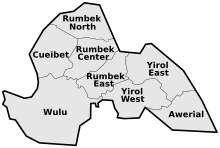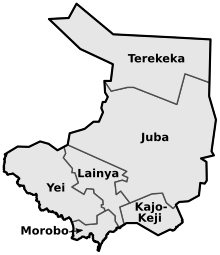 |
|---|
| Constitution |
The 10 states and 3 administrative areas of South Sudan are divided into 79 counties.[1][2]
History
[edit]Before the independence of South Sudan from Sudan, the Counties were known as Districts. Upon Independence in 2011, the 10 states of South Sudan were divided into 79 counties. More counties were established during the South Sudanese Civil War, when the country increased to 32 states, and the number of counties exceeded 100. However, with the return to 10 states and 3 administrative areas in 2020, South Sudan reverted to 79 counties.[2]


A

- Awerial County
- Cueibet County
- Rumbek Center County
- Rumbek East County
- Rumbek North County
- Wulu County
- Yirol East County
- Yirol West County
- Adior County

- Gogrial East County
- Gogrial West County
- Tonj East County
- Tonj North County
- Tonj South County
- Twic County

- Ezo County
- Ibba County
- Maridi County
- Mundri East County
- Mundri West County
- Mvolo County
- Nagero County
- Nzara County
- Tambura County
- Yambio County


- Imehejek county (administrative area)
- Kapoeta East County
- Kapoeta North County
- Kapoeta South County
- Lafon County
- Magwi County
- Torit County

- Akobo County
- Ayod County
- Bor County
- Duk County
- Fangak County
- Nyirol County
- Pigi County
- Twic East County
- Uror County


- Baliet County
- Fashoda County
- Longechuk County
- Maban County
- Maiwut County
- Malakal County
- Manyo County
- Melut County
- Nasir County
- Panykang County
- Renk County
- Ulang County
- Akoka County


- Pibor County
- Pochalla County
- Muruou County
See also
[edit]References
[edit]- ^ United Nations Development Programme-Sudan Archived 2011-07-28 at the Wayback Machine
- ^ a b Wël, PaanLuel (2020-02-15). "President Kiir Reinstates 10 States, 79 Counties and Fires all 32 State Governors in South Sudan". PaanLuel Wël Media Ltd - South Sudan. Retrieved 2020-09-13.
Well, that’s interesting to know that Psilotum nudum are known as whisk ferns. Psilotum nudum is the commoner species of the two. While the P. flaccidum is a rare species and is found in the tropical islands. Both the species are usually epiphytic in habit and grow upon tree ferns. These species may also be terrestrial and grow in humus or in the crevices of the rocks.
View the detailed Guide of Psilotum nudum: Detailed Study Of Psilotum Nudum (Whisk Fern), Classification, Anatomy, Reproduction